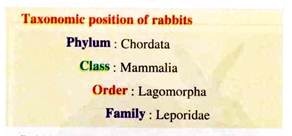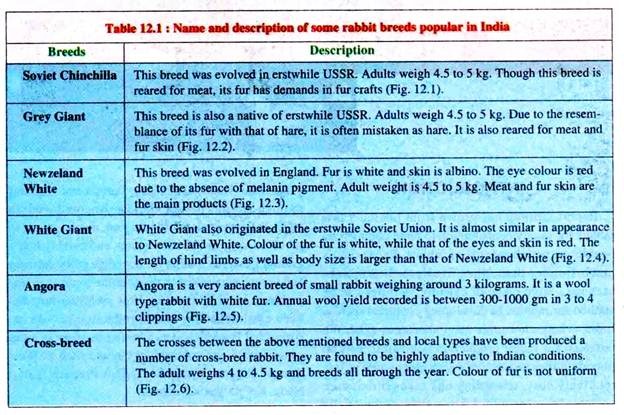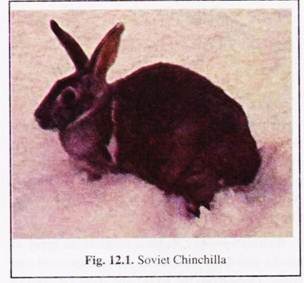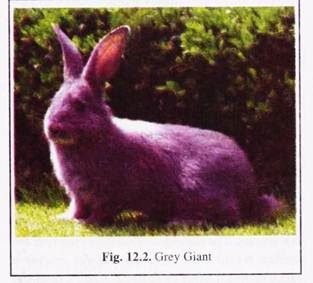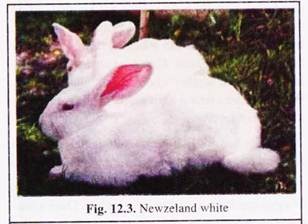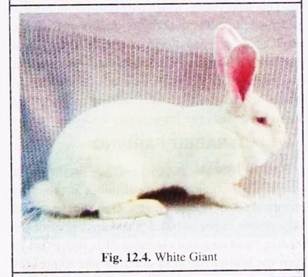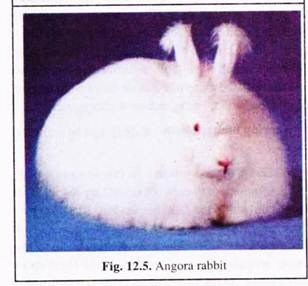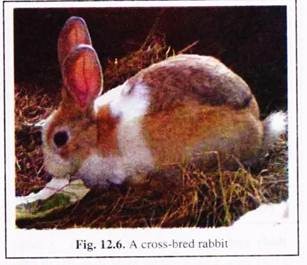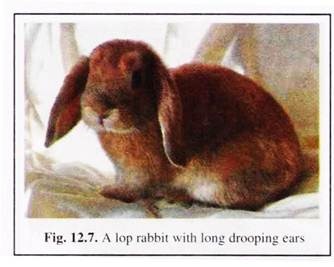In this article we will discuss about Rabbit:- 1. History of Rabbit 2. Breeds of Rabbit 3. Life History 4. Body and Appearance 5. Life Cycle 6. Uses.
History of Rabbit:
Rabbit keeping in commercial base started in the last century. The scarcity of food following first and second World Wars paves the way for extensive rabbit rearing. During those times, rabbit’s flesh was denoted as ‘Underground Mutton’ and served as a source of food for rural families. Later on, F.A.O. through different package programmes encouraged the farmers for rabbit farming.
Thus, rabbit farming gradually spread to different countries. In India, from early sixties rabbit farming gained importance in places like Himachal Pradesh, Jammu and Kashmir through introduction of German Angora breed.
In 1977, the government of India took much interest in rabbit raising in different states and established a Central Research Station to encourage rabbit farming and to envisage research programme to mitigate the problems in rabbit farming.
ADVERTISEMENTS:
Now rabbit farming has been established for wool production in Sikkim, Arunachal Pradesh and as a broiler industry in areas of temperate and subtropical climate such as West Bengal, Assam, Manipur, Andhra Pradesh, Tamil Nadu, Kerala and Karnataka.
Rabbits are small mammals in the family Leporidae; there are eight different genera in this famil y, classified as rabbits which are distributed in different parts of the world, viz., Pentalagus, Bunolagu, Nesolagus, Romerolagu, Brachylagus, Sylvilagus, Orytolagus and Poelagus.
Breeds of Rabbit:
Rabbits come in an array of breeds with different colours, sizes, shapes and coat types. Throughout the world, different varieties of domestic rabbit were created through selective breeding or natural selection.
ADVERTISEMENTS:
Most of the breeds were originally developed for one of the following purposes: meat, pelt, wools, show or biological research. Here few popular rabbit breeds reared in Indian farms are being described (Table 12.1).
Life History of Rabbits:
Wild rabbits are found in many places around the world. They are present in many habitats, including woods, forests, grasslands, deserts and wetlands. In the wild, rabbits live in groups of up to 70 in number. They make homes under the ground in a series of tunnels called burrows.
A group of burrows is called a warren. Rabbits are herbivores. They pass two different kinds of droppings. Faecal pellets are hard, round droppings that are normally produced from wastes of indigestable plant fibres.
Cecotropes, on the other hand, are soft, dark-coloured droppings produced as a result of incomplete digestion of nutrient-rich food by cecum, which rabbits re-ingest to obtain extra nutrients. Consuming cecotropes is known as coprophagy.
Body and Appearance of Rabbit:
A rabbit has long ears, which can be more than 10 cm long. Some kinds of rabbit have ears called lops which flop down (e.g., Holand Hop rabbit; Fig. 12.7). Rabbits have large, strong hind legs. Each front foot has five toes, and each hind foot has four.
ADVERTISEMENTS:
They move on the tips of their toes. Their body can be 20 cm to 50 cm long and weighs up to 5 kg. Their fur is generally long and soft, but varies according to the breed and can be brown, grey, creamy or white in colour. They have small tail, sometimes white on top. In their natural habitats, the rabbits show excellent hearing and speed. Rabbits have two sets of incisor teeth, one behind the other. Their teeth grow constantly.
Life Cycle of Rabbit:
Male rabbits are also referred to as bucks, females are does, and newborns are kits or bunnies. They attain sexual maturity in five to six months.
In females ovulation occurs only after mating. A female rabbit is, therefore, considered to be in heat when she accepts service (an act of mating by male) and in diestrus when she refuses the buck. The sexual behaviour of a female rabbit is thus very special.
She has no reproductive cycle but can stay in heat for several continuous days. After mating with a buck, a doe is pregnant for about 30 days and gives birth to a litter of about 4 to 12 kits. Rabbits can breed eight times a year.
They have got fast reproductive process and are able to remate within 24 hours of giving birth (kindling). Usually baby rabbits are kindled during the night and are born small, blind and hairless. Bunnies open their eyes when 10 days old. A day later they begin to hear. They feed on very nutritious milk from their mother’s body for about 4-5 weeks. When they are about 3 weeks old, they leave the nest in search of feed.
Rabbits live for 8-10 years, although it has been reported to live longer.
Cannibalism:
Cannibalism or eating organisms of same species is also shown by rabbits. Does sometimes eat their young, which may result from a ration inadequate in either quantity or quality or from the nervousness of a doe disturbed after kindling. Does usually do not kill and eat healthy bunnies, but limit their cannibalism to those born dead or those that are injured and have died. Proper feeding and handling during pregnancy can prevent this tendency.
Uses of Rabbits
Meat:
Fresh or frozen rabbit meat is sold all year round. It can be used in similar ways as chicken is used.
Wool:
Angora rabbits are mainly raised for their wool, which is known for its quality. Angora rabbits are of many types. The differences are mainly in the amount of wool produced and the percentage of guard hair in the wool. Among the various types, German Angora is the best and annually yields 1000 to 1200 gm of wool under ideal management practices.
Laboratory:
Rabbits are widely used for biological and medicine laboratories. Such rabbit farming is governed by specific guidelines.
Manure as a Fertilizer:
As the cost of fertiliser product increases, so does the value of rabbit manure. Fifteen does, two bucks, and their litters will produce approximately one tonne of manure a year. Rabbit manure is drier than poultry manure. Rabbit manure contains approximately 1.3% N, 0.9% P, 1.0% K and fetches a good price in the market.
